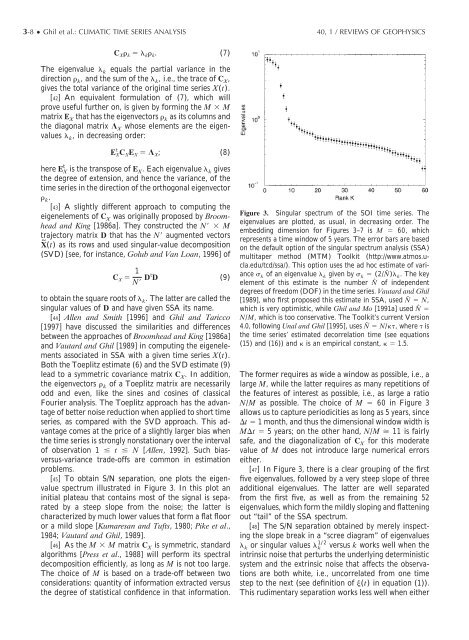advanced spectral methods for climatic time series - Atmospheric ...
advanced spectral methods for climatic time series - Atmospheric ...
advanced spectral methods for climatic time series - Atmospheric ...
Create successful ePaper yourself
Turn your PDF publications into a flip-book with our unique Google optimized e-Paper software.
3-8 ● Ghil et al.: CLIMATIC TIME SERIES ANALYSIS 40, 1 / REVIEWS OF GEOPHYSICS<br />
C X k k k. (7)<br />
The eigenvalue k equals the partial variance in the<br />
direction k, and the sum of the k, i.e., the trace of C X,<br />
gives the total variance of the original <strong>time</strong> <strong>series</strong> X(t).<br />
[42] An equivalent <strong>for</strong>mulation of (7), which will<br />
prove useful further on, is given by <strong>for</strong>ming the M M<br />
matrix E X that has the eigenvectors k as its columns and<br />
the diagonal matrix X whose elements are the eigenvalues<br />
k, in decreasing order:<br />
E X t CXE X X; (8)<br />
t<br />
here EX is the transpose of EX. Each eigenvalue k gives<br />
the degree of extension, and hence the variance, of the<br />
<strong>time</strong> <strong>series</strong> in the direction of the orthogonal eigenvector<br />
k. [43] A slightly different approach to computing the<br />
eigenelements of CX was originally proposed by Broomhead<br />
and King [1986a]. They constructed the N M<br />
trajectory matrix D that has the N augmented vectors<br />
X˜(t) as its rows and used singular-value decomposition<br />
(SVD) [see, <strong>for</strong> instance, Golub and Van Loan, 1996] of<br />
C X 1<br />
N Dt D (9)<br />
to obtain the square roots of k. The latter are called the<br />
singular values of D and have given SSA its name.<br />
[44] Allen and Smith [1996] and Ghil and Taricco<br />
[1997] have discussed the similarities and differences<br />
between the approaches of Broomhead and King [1986a]<br />
and Vautard and Ghil [1989] in computing the eigenelements<br />
associated in SSA with a given <strong>time</strong> <strong>series</strong> X(t).<br />
Both the Toeplitz estimate (6) and the SVD estimate (9)<br />
lead to a symmetric covariance matrix C X. In addition,<br />
the eigenvectors k of a Toeplitz matrix are necessarily<br />
odd and even, like the sines and cosines of classical<br />
Fourier analysis. The Toeplitz approach has the advantage<br />
of better noise reduction when applied to short <strong>time</strong><br />
<strong>series</strong>, as compared with the SVD approach. This advantage<br />
comes at the price of a slightly larger bias when<br />
the <strong>time</strong> <strong>series</strong> is strongly nonstationary over the interval<br />
of observation 1 t N [Allen, 1992]. Such biasversus-variance<br />
trade-offs are common in estimation<br />
problems.<br />
[45] To obtain S/N separation, one plots the eigenvalue<br />
spectrum illustrated in Figure 3. In this plot an<br />
initial plateau that contains most of the signal is separated<br />
by a steep slope from the noise; the latter is<br />
characterized by much lower values that <strong>for</strong>m a flat floor<br />
or a mild slope [Kumaresan and Tufts, 1980; Pike et al.,<br />
1984; Vautard and Ghil, 1989].<br />
[46] As the M M matrix C X is symmetric, standard<br />
algorithms [Press et al., 1988] will per<strong>for</strong>m its <strong>spectral</strong><br />
decomposition efficiently, as long as M is not too large.<br />
The choice of M is based on a trade-off between two<br />
considerations: quantity of in<strong>for</strong>mation extracted versus<br />
the degree of statistical confidence in that in<strong>for</strong>mation.<br />
Figure 3. Singular spectrum of the SOI <strong>time</strong> <strong>series</strong>. The<br />
eigenvalues are plotted, as usual, in decreasing order. The<br />
embedding dimension <strong>for</strong> Figures 3–7 is M 60, which<br />
represents a <strong>time</strong> window of 5 years. The error bars are based<br />
on the default option of the singular spectrum analysis (SSA)<br />
multitaper method (MTM) Toolkit (http://www.atmos.ucla.edu/tcd/ssa/).<br />
This option uses the ad hoc estimate of variance<br />
k of an eigenvalue k given by k (2/Nˆ ) k. The key<br />
element of this estimate is the number Nˆ of independent<br />
degrees of freedom (DOF) in the <strong>time</strong> <strong>series</strong>. Vautard and Ghil<br />
[1989], who first proposed this estimate in SSA, used Nˆ N,<br />
which is very optimistic, while Ghil and Mo [1991a] used Nˆ <br />
N/M, which is too conservative. The Toolkit’s current Version<br />
4.0, following Unal and Ghil [1995], uses Nˆ N/, where is<br />
the <strong>time</strong> <strong>series</strong>’ estimated decorrelation <strong>time</strong> (see equations<br />
(15) and (16)) and is an empirical constant, 1.5.<br />
The <strong>for</strong>mer requires as wide a window as possible, i.e., a<br />
large M, while the latter requires as many repetitions of<br />
the features of interest as possible, i.e., as large a ratio<br />
N/M as possible. The choice of M 60 in Figure 3<br />
allows us to capture periodicities as long as 5 years, since<br />
t 1 month, and thus the dimensional window width is<br />
Mt 5 years; on the other hand, N/M 11 is fairly<br />
safe, and the diagonalization of C X <strong>for</strong> this moderate<br />
value of M does not introduce large numerical errors<br />
either.<br />
[47] In Figure 3, there is a clear grouping of the first<br />
five eigenvalues, followed by a very steep slope of three<br />
additional eigenvalues. The latter are well separated<br />
from the first five, as well as from the remaining 52<br />
eigenvalues, which <strong>for</strong>m the mildly sloping and flattening<br />
out “tail” of the SSA spectrum.<br />
[48] The S/N separation obtained by merely inspecting<br />
the slope break in a “scree diagram” of eigenvalues<br />
k or singular values k 1/2 versus k works well when the<br />
intrinsic noise that perturbs the underlying deterministic<br />
system and the extrinsic noise that affects the observations<br />
are both white, i.e., uncorrelated from one <strong>time</strong><br />
step to the next (see definition of (t) in equation (1)).<br />
This rudimentary separation works less well when either






